Share this
Semi-Rugged vs. Fully Rugged vs. Ultra-Rugged: What's the Difference?
by Brett Daniel on Jun 5, 2020 2:58:51 PM
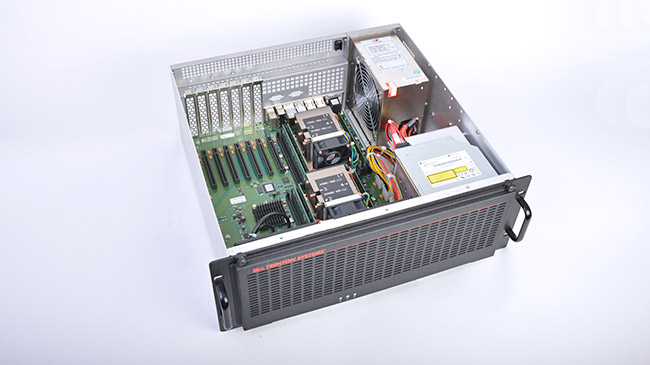
Photo: A Trenton Systems 4U rugged server
While perusing the many different rugged computers and servers on the market, you may have encountered three categories of ruggedization: semi-rugged, fully rugged and ultra-rugged.
For example, we at Trenton Systems offer fully rugged servers and workstations, and we’re currently working on an ultra-rugged embedded computer, the COM Express Type 7.
But what do each of these categories even mean, and why is it important to know the difference?
We’ll cover all the bases in this blog post.
Before we move on, however, it’s important to note that these categories are not standardized by any organizational body.
A device that one rugged computer hardware manufacturer says is fully rugged may be considered semi-rugged or even ultra-rugged by another; therefore, we’ve based our definitions on how the industry commonly uses these terms.
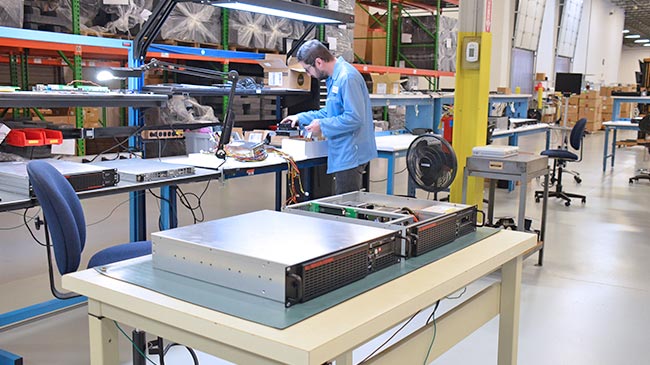
Photo: Two Trenton Systems 2U rugged workstations in our Lawrenceville, Georgia facility
What is rugged design?
If a server, workstation, mini PC or other computer has a rugged design, it’s been stress-tested to endure, function and perform in extreme environments, usually according to military and industrial standards, such as MIL-STD-810, MIL-STD-461 or DO-160.
When a rugged device is placed in a harsh environment – this could be a location that receives extremely high or low temperatures or a place with lots of moving parts, such as a factory floor - the ruggedization process ensures the survival of not only the device’s chassis or outer casing but also its internal components.
Rugged computers are used in a variety of industries, including defense, space, aviation, aerospace, big data, industrial automation, health care, entertainment, agriculture, energy and telecommunications.
It’s important to note, however, that not every rugged device has been certified to military or industrial standards. It’s possible to purchase a rugged device that has undergone some form of stress testing but not the standardization and certification process, which is desirable and necessary if the device is intended to support an important military or industrial application in a harsh environment.
If you’re looking for a device with legitimate rugged design - one that will perform in the face of many different environmental conditions, such as high humidity, high or low temperatures, vibration, mechanical shock, among others - certifications are the golden ticket of ruggedization. They are what make a rugged computer truly rugged.
.jpeg?width=5120&name=Military%20LP%20Original%20(1).jpeg)
Photo: The United States military is an avid user of rugged devices.
When would a rugged device be used?
A rugged device could be used by the military to support mission-critical weapons, radar and communications systems, or by industries to support assembly line automation and collect field data.
Any program or application that requires durability and powerful performance can benefit from the introduction of a rugged computer or device. Not to mention, the possibilities are seemingly endless, especially with the advent of edge computing.
One example of a rugged device in use is a ruggedized processor board installed on a United States Air Force fighter jet.
In 2009, the Air Force needed a customized processor board for use in the heads-up display (HUD) of one of its fighter jets. The board had to be able to withstand hot temperatures on the tarmac and cold temperatures at high altitudes.
Looking to the rugged computing industry for help, the Air Force was able to secure a MIL-STD-810-temperature-certified processor board offering more than enough durability to support the HUD. In fact, the Air Force went on to purchase 600 of these processor boards for use with its other aircraft. A consumer-level processor board simply wouldn’t survive the hot and cold temperatures specific to this program.
Now that we’ve discussed rugged design and usage of rugged devices, let’s discuss the different categories of ruggedization.
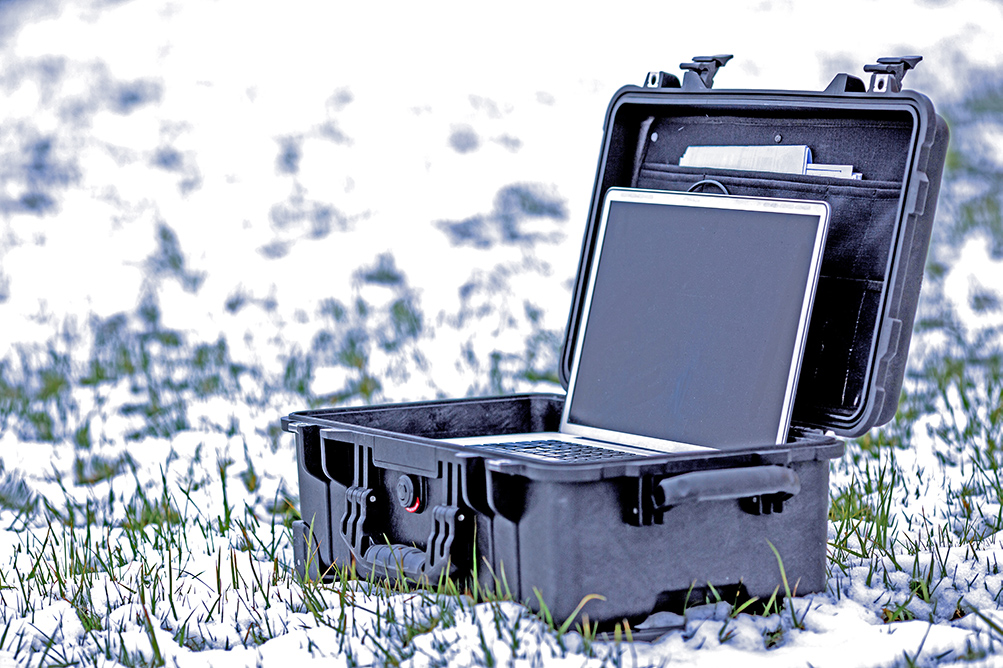
Photo: A rugged laptop in a snowy environment
What is semi-rugged?
A semi-rugged device is commonly seen at the consumer level supporting law enforcement and business-related applications and projects. It’s helpful to think of a semi-rugged device as a commercial-off-the-shelf computer with limited rugged features.
Semi-rugged devices are typically equipped with a few parts that have undergone stress testing or certification to military and industrial standards. For instance, a semi-rugged device may have a hard drive that’s resistant to mechanical shock, or an outer covering that can withstand some rain.
One example of a semi-rugged device is a police computer, which may be dropped, impacted during a high-speed chase, or exposed to rain and extreme temperatures.
Unfortunately, semi-rugged devices are likely to suffer if pushed too far. In other words, if the environment becomes too harsh, a semi-rugged device could experience a significant performance decline or stop working altogether.
Fully rugged and ultra-rugged devices don’t suffer the same fate, as all their components and hardware have been designed to both endure and perform, no matter the severity of the environment.
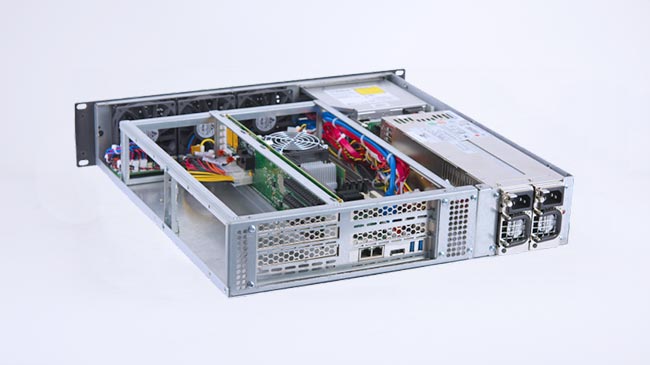
Photo: A Trenton Systems 2U rugged server
What is fully rugged?
Fully rugged devices are commonly seen supporting military and industrial applications in riskier environments than the semi-rugged device. Simply put, they’re more durable than the semi-rugged device but less ruggedized than the specialized ultra-rugged device.
Depending on their certifications, fully rugged devices can be dropped, impacted, exposed to extremely high or low temperatures, withstand high levels of humidity, endure heavy rain and direct sunlight exposure for prolonged periods, and the list goes on.
An example of a fully rugged device is a military computer or a rugged blade server and its electronic components.
Fully rugged devices won’t suffer from a performance decline in extreme environments. This makes them ideal for mission-critical applications, which require continuous operation.
Trenton Systems specializes in fully rugged servers, workstations, storage, mini PCs, processor boards and backplanes.
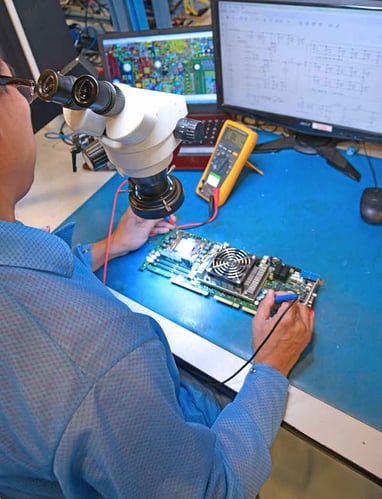
Photo: Ultra-rugged devices and components are particularly tough by design.
What is ultra-rugged?
Looking for a basically indestructible rugged device?
Ultra-rugged devices are a little pricier than fully rugged devices, but they go the extra mile in terms of durability. They’re designed to endure the harshest conditions the world has to offer.
These devices are stress-tested beyond the requirements of the semi-rugged and fully rugged devices. If you’re looking for a device that can be literally frozen, left out in the desert sun, or dropped from three feet onto a cement floor, the ultra-rugged device is the right choice.
Conclusion
To recap:
- A semi-rugged device is often seen at the consumer level supporting business and law enforcement applications and projects. Semi-rugged devices are usually just commercial-off-the-shelf computers with additional but limited rugged features.
- A fully rugged device is often seen supporting military and industrial applications in riskier environments than the semi-rugged device. They’re more durable than the semi-rugged device but less ruggedized than the specialized ultra-rugged device.
- An ultra-rugged device is designed to endure the absolute harshest conditions the world has to offer. The industry often refers to them as indestructible due to their enhanced durability.
If you're unsure about which category your rugged device falls under, ask the manufacturer, and don't take a chance on uncertified rugged devices.
Experience the Trenton Rugged ™ difference.
Share this
- High-performance computers (42)
- Military computers (38)
- Rugged computers (32)
- Cybersecurity (25)
- Industrial computers (25)
- Military servers (24)
- MIL-SPEC (20)
- Rugged servers (19)
- Press Release (17)
- Industrial servers (16)
- MIL-STD-810 (16)
- 5G Technology (14)
- Intel (13)
- Rack mount servers (12)
- processing (12)
- Computer hardware (11)
- Edge computing (11)
- Rugged workstations (11)
- Made in USA (10)
- Partnerships (9)
- Rugged computing (9)
- Sales, Marketing, and Business Development (9)
- Trenton Systems (9)
- networking (9)
- Peripheral Component Interconnect Express (PCIe) (7)
- Encryption (6)
- Federal Information Processing Standards (FIPS) (6)
- GPUs (6)
- IPU (6)
- Joint All-Domain Command and Control (JADC2) (6)
- Server motherboards (6)
- artificial intelligence (6)
- Computer stress tests (5)
- Cross domain solutions (5)
- Mission-critical servers (5)
- Rugged mini PCs (5)
- AI (4)
- BIOS (4)
- CPU (4)
- Defense (4)
- Military primes (4)
- Mission-critical systems (4)
- Platform Firmware Resilience (PFR) (4)
- Rugged blade servers (4)
- containerization (4)
- data protection (4)
- virtualization (4)
- Counterfeit electronic parts (3)
- DO-160 (3)
- Edge servers (3)
- Firmware (3)
- HPC (3)
- Just a Bunch of Disks (JBOD) (3)
- Leadership (3)
- Navy (3)
- O-RAN (3)
- RAID (3)
- RAM (3)
- Revision control (3)
- Ruggedization (3)
- SATCOM (3)
- Storage servers (3)
- Supply chain (3)
- Tactical Advanced Computer (TAC) (3)
- Wide-temp computers (3)
- computers made in the USA (3)
- data transfer (3)
- deep learning (3)
- embedded computers (3)
- embedded systems (3)
- firmware security (3)
- machine learning (3)
- Automatic test equipment (ATE) (2)
- C6ISR (2)
- COTS (2)
- COVID-19 (2)
- CPUs (2)
- Compliance (2)
- Compute Express Link (CXL) (2)
- Computer networking (2)
- Controlled Unclassified Information (CUI) (2)
- DDR (2)
- DDR4 (2)
- DPU (2)
- Dual CPU motherboards (2)
- EW (2)
- I/O (2)
- Military standards (2)
- NVIDIA (2)
- NVMe SSDs (2)
- PCIe (2)
- PCIe 4.0 (2)
- PCIe 5.0 (2)
- RAN (2)
- SIGINT (2)
- SWaP-C (2)
- Software Guard Extensions (SGX) (2)
- Submarines (2)
- Supply chain security (2)
- TAA compliance (2)
- airborne (2)
- as9100d (2)
- chassis (2)
- data diode (2)
- end-to-end solution (2)
- hardware security (2)
- hardware virtualization (2)
- integrated combat system (2)
- manufacturing reps (2)
- memory (2)
- mission computers (2)
- private 5G (2)
- protection (2)
- secure by design (2)
- small form factor (2)
- software security (2)
- vRAN (2)
- zero trust (2)
- zero trust architecture (2)
- 3U BAM Server (1)
- 4G (1)
- 4U (1)
- 5G Frequencies (1)
- 5G Frequency Bands (1)
- AI/ML/DL (1)
- Access CDS (1)
- Aegis Combat System (1)
- Armed Forces (1)
- Asymmetric encryption (1)
- C-RAN (1)
- COMINT (1)
- Cloud-based CDS (1)
- Coast Guard (1)
- Compliance testing (1)
- Computer life cycle (1)
- Containers (1)
- D-RAN (1)
- DART (1)
- DDR5 (1)
- DMEA (1)
- Data Center Modular Hardware System (DC-MHS) (1)
- Data Plane Development Kit (DPDK) (1)
- Defense Advanced Research Projects (DARP) (1)
- ELINT (1)
- EMI (1)
- EO/IR (1)
- Electromagnetic Interference (1)
- Electronic Warfare (EW) (1)
- FIPS 140-2 (1)
- FIPS 140-3 (1)
- Field Programmable Gate Array (FPGA) (1)
- Ground Control Stations (GCS) (1)
- Hardware-based CDS (1)
- Hybrid CDS (1)
- IES.5G (1)
- ION Mini PC (1)
- IP Ratings (1)
- IPMI (1)
- Industrial Internet of Things (IIoT) (1)
- Industry news (1)
- Integrated Base Defense (IBD) (1)
- LAN ports (1)
- LTE (1)
- Life cycle management (1)
- Lockheed Martin (1)
- MIL-S-901 (1)
- MIL-STD-167-1 (1)
- MIL-STD-461 (1)
- MIL-STD-464 (1)
- MOSA (1)
- Multi-Access Edge Computing (1)
- NASA (1)
- NIC (1)
- NIC Card (1)
- NVMe (1)
- O-RAN compliant (1)
- Oil and Gas (1)
- Open Compute Project (OCP) (1)
- OpenRAN (1)
- P4 (1)
- PCIe card (1)
- PCIe lane (1)
- PCIe slot (1)
- Precision timestamping (1)
- Product life cycle (1)
- ROM (1)
- Raytheon (1)
- Remotely piloted aircraft (RPA) (1)
- Rugged computing glossary (1)
- SEDs (1)
- SIM Card (1)
- Secure boot (1)
- Sensor Open Systems Architecture (SOSA) (1)
- Small form-factor pluggable (SFP) (1)
- Smart Edge (1)
- Smart NIC (1)
- SmartNIC (1)
- Software-based CDS (1)
- Symmetric encryption (1)
- System hardening (1)
- System hardening best practices (1)
- TME (1)
- Tech Partners (1)
- Total Memory Encryption (TME) (1)
- Transfer CDS (1)
- USB ports (1)
- VMEbus International Trade Association (VITA) (1)
- Vertical Lift Consortium (VLC) (1)
- Virtual machines (1)
- What are embedded systems? (1)
- Wired access backhaul (1)
- Wireless access backhaul (1)
- accredidation (1)
- aerospace (1)
- air gaps (1)
- airborne computers (1)
- asteroid (1)
- authentication (1)
- autonomous (1)
- certification (1)
- cognitive software-defined radios (CDRS) (1)
- command and control (C2) (1)
- communications (1)
- cores (1)
- custom (1)
- customer service (1)
- customer support (1)
- data linking (1)
- data recording (1)
- ethernet (1)
- full disk encryption (1)
- hardware monitoring (1)
- heat sink (1)
- hypervisor (1)
- in-house technical support (1)
- input (1)
- integrated edge solution (1)
- international business (1)
- licensed spectrum (1)
- liquid cooling (1)
- mCOTS (1)
- microelectronics (1)
- missile defense (1)
- mixed criticality (1)
- moving (1)
- multi-factor authentication (1)
- network slicing (1)
- neural networks (1)
- new headquarters (1)
- next generation interceptor (1)
- non-volatile memory (1)
- operating system (1)
- output (1)
- outsourced technical support (1)
- post-boot (1)
- pre-boot (1)
- private networks (1)
- public networks (1)
- radio access network (RAN) (1)
- reconnaissance (1)
- rugged memory (1)
- secure flash (1)
- security (1)
- self-encrypting drives (SEDs) (1)
- sff (1)
- software (1)
- software-defined radios (SDRs) (1)
- speeds and feeds (1)
- standalone (1)
- storage (1)
- systems (1)
- tactical wide area networks (1)
- technical support (1)
- technology (1)
- third-party motherboards (1)
- troposcatter communication (1)
- unlicensed spectrum (1)
- volatile memory (1)
- vpx (1)
- zero trust network (1)
- January 2025 (1)
- November 2024 (1)
- October 2024 (1)
- August 2024 (1)
- July 2024 (1)
- May 2024 (1)
- April 2024 (3)
- February 2024 (1)
- November 2023 (1)
- October 2023 (1)
- July 2023 (1)
- June 2023 (3)
- May 2023 (7)
- April 2023 (5)
- March 2023 (7)
- December 2022 (2)
- November 2022 (6)
- October 2022 (7)
- September 2022 (8)
- August 2022 (3)
- July 2022 (4)
- June 2022 (13)
- May 2022 (10)
- April 2022 (4)
- March 2022 (11)
- February 2022 (4)
- January 2022 (4)
- December 2021 (1)
- November 2021 (4)
- September 2021 (2)
- August 2021 (1)
- July 2021 (2)
- June 2021 (3)
- May 2021 (4)
- April 2021 (3)
- March 2021 (3)
- February 2021 (8)
- January 2021 (4)
- December 2020 (5)
- November 2020 (5)
- October 2020 (4)
- September 2020 (4)
- August 2020 (6)
- July 2020 (9)
- June 2020 (11)
- May 2020 (13)
- April 2020 (8)
- February 2020 (1)
- January 2020 (1)
- October 2019 (1)
- August 2019 (2)
- July 2019 (2)
- March 2019 (1)
- January 2019 (2)
- December 2018 (1)
- November 2018 (2)
- October 2018 (5)
- September 2018 (3)
- July 2018 (1)
- April 2018 (2)
- March 2018 (1)
- February 2018 (9)
- January 2018 (27)
- December 2017 (1)
- November 2017 (2)
- October 2017 (3)
/Trenton%20Systems%20Circular%20Logo-3.png?width=50&height=50&name=Trenton%20Systems%20Circular%20Logo-3.png)


No Comments Yet
Let us know what you think